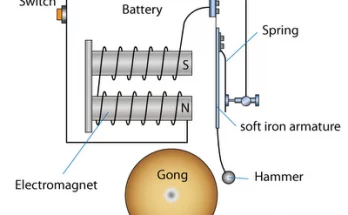Objective- This activity aims to teach students how to build an electromagnet and explore its properties and applications, illustrating the relationship between electricity and magnetism.
Concepts to Understand-
- Electromagnetism- When electric current passes through a coil of wire wrapped around a ferromagnetic material (like iron), it creates a magnetic field, turning the material into a magnet. This is called an electromagnet.
- Ferromagnetic Material- A material like iron that can become magnetised when placed in a magnetic field.
Materials Needed-
- A long piece of insulated wire (about 75 cm)
- An iron nail (6-10 cm long)
- An electric cell
- A switch
- Small objects like pins or paper clips
Steps to Follow-
Creating the Electromagnet-
- Wind the insulated wire tightly around the iron nail, forming a coil. Leave some free wire at both ends for connections.
- Connect one end of the coiled wire to the positive terminal of the cell.
- Attach the other end of the wire to one terminal of the switch.
- Connect a wire from the other terminal of the switch to the negative terminal of the cell, completing the circuit.
Testing the Electromagnet-

- Place some pins or paper clips near the tip of the iron nail.
- Turn on the switch to allow current to flow through the coil.
- Observe whether the pins cling to the end of the nail.
Observing the Effect of Current-
- Note if the pins stick to the nail only when the current is on and if they fall off when the current is off.
- Discuss why the nail behaves like a magnet only when current flows through the coil.
Understanding the Concept-
- The iron nail becomes a temporary magnet (an electromagnet) when electric current flows through the coiled wire around it.
- This happens because the current generates a magnetic field, which magnetises the iron nail.
- When the current is switched off, the nail loses its magnetism, demonstrating the temporary nature of electromagnets.
Applications of Electromagnets-
- Electromagnets are used in various applications due to their ability to turn magnetism on and off with electricity. For example, they are used in cranes for lifting heavy magnetic materials and in many devices like electric bells and speakers.
Conclusion-
By building and experimenting with an electromagnet, students gain a practical understanding of electromagnetism. They learn how electricity can create magnetism and the various applications of this phenomenon in everyday technology. This activity serves as a foundation for understanding more complex concepts in physics and engineering.
Also Check – Chapter 10: A Detailed Guide to “Electric Current and its Effects” Activities for Class 7 Students
Also Check- Electromagnets- A Guide for Upper Primary Students
Also Check- Chapter 10 – Electric Current and its Effects – 5 Worksheets Solved and Unsolved
Also Check- Electric Bell Diagram for Class 7 Science
Also Check- Rapid Revision – Class 7 Science- Chapter 14 – Electric Current and Its Effects
Also Check- Chapter 14- Electric Current and Its Effects-Class 7 science- Question and Answers
Also Check- Chapter 14- Electric Current and Its Effects–Class 7 science- Question and Answer -(Solved MCQs)
Also Check- NCERT Exemplar Solutions- Class 7 Science- Chapter 14 – Electric Current and Its Effects
Also Check- NCERT Solutions for Class 7 Science Chapter 14- Electric Current and its Effects
Also Check- Class 7 science -Chapter 14 – Electric Current and Its Effects- Complete Notes
Also Check – Electric Bell Working Mechanism Simplified for Students
Also Check- Batteries- The Powerhouses of Everyday Life – A Guide for Upper Primary Students

